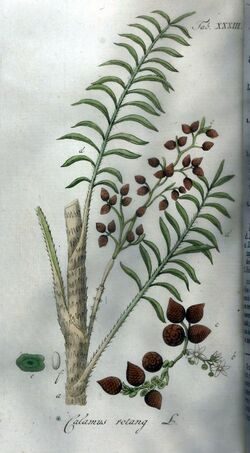Biology:Calamus rotang
| Calamus rotang | |
|---|---|

| |
| Scientific classification | |
| Kingdom: | Plantae |
| Clade: | Tracheophytes |
| Clade: | Angiosperms |
| Clade: | Monocots |
| Clade: | Commelinids |
| Order: | Arecales |
| Family: | Arecaceae |
| Genus: | Calamus |
| Species: | C. rotang
|
| Binomial name | |
| Calamus rotang | |
| Synonyms[1] | |
| |
Calamus rotang, also known as common rattan, is a plant species native to India , Sri Lanka and Myanmar (Burma). It is one of the scandent (climbing) rattan palms used to make Malacca cane furniture, baskets, walking-sticks, umbrellas, tables and general wickerwork, and is found in Southwest Asia. The basal section of the plant grows vertically for 10 metres or so, after which the slender, tough stem of a few centimetres in diameter, grows horizontally for 200 metres or more. It is extremely flexible and uniform in thickness, and frequently has sheaths and petioles armed with backward-facing spines which enable it to scramble over other plants. It has pinnate, alternate leaves, 60–80 cm long, armed with two rows of spines on the upper face.[2]
The plants are dioecious, and flowers are clustered in attractive inflorescences, enclosed by spiny spathes. The edible fruits are top-shaped, covered in shiny, reddish-brown imbricate scales, and exude an astringent red resin known medicinally and commercially as "dragon's blood".[3]
The canes are sought-after and expensive, but have to a large extent been replaced by sticks made from plants, such as bamboos, rushes and osier willows.[4]
Gallery
References
- ↑ "The Plant List, Calamus rotang". http://www.theplantlist.org/tpl1.1/record/kew-29891.
- ↑ India Biodiversity Portal, Calamus rotang L., common rattan
- ↑ "Missouri Botanical Garden". http://www.illustratedgarden.org/mobot/rarebooks/page.asp?relation=QK91C7431790V3&identifier=0190.
- ↑ "Rattan Palm". http://www.dipbot.unict.it/Palms/Descr03.html.
External links
- The rattan palm by Anna Guglielmo, Pietro Pavone and Cristina Salmeri
- Carl Ludwig Blume's Rumphia vol.3 with numerous plates of rattan palms
Wikidata ☰ Q416369 entry
 |






